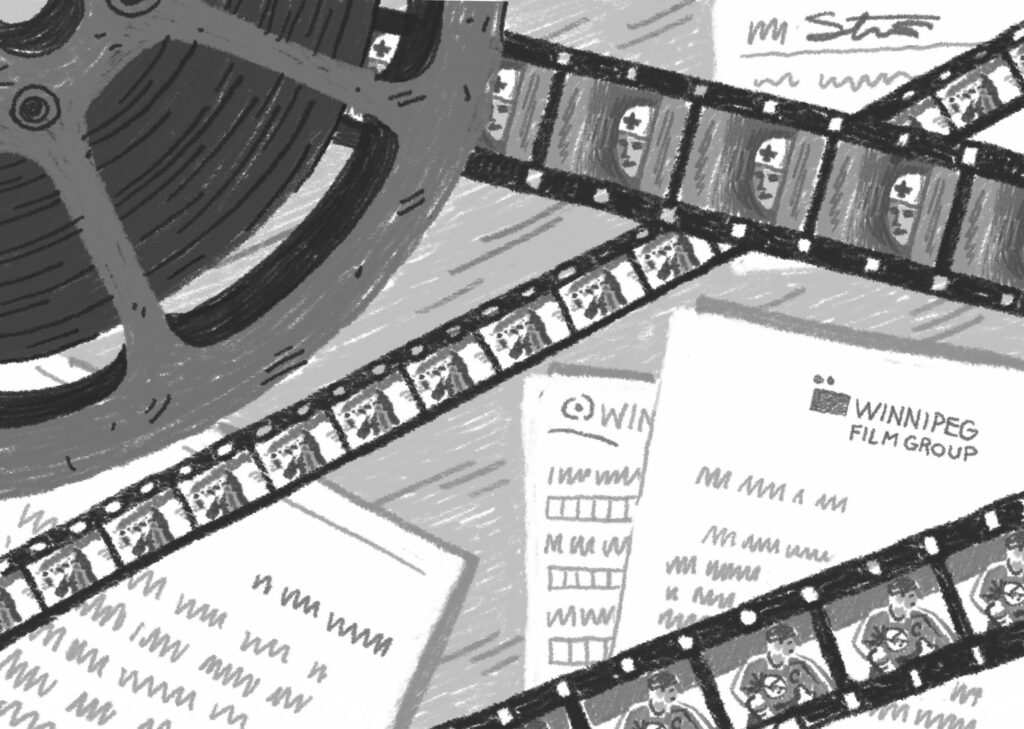The story behind Ed Ackerman and Greg Zbitnew’s short film 5¢ a Copy fairly describes how art comes together in Winnipeg. It’s 1980, and members of the Winnipeg Film Group, an artists’ collective formed in 1974 with a manifesto typical of its era (earnest, vague), decide they’re important enough now to buy a photocopier for the office. Some are unhappy about the decision. Shouldn’t they be spending grant money on things like cameras and film? Ackerman and Zbitnew respond not with a memo or a motion at a meeting but with a surreal animation made up of photocopied faces and cut‑outs, three minutes long.
Decades later, this is still how things work in the city’s creative community. It’s not about the weather. It’s not about something in the water. It’s about the option, when you have something to say, not to complain but to make a movie (or a painting or a poem), because there’s no one to tell you that you can’t, like in Toronto. Bonus if it’s funny.
This idea, the primacy of freedom and wit over commerce, runs throughout Establishing Shots, in which Kevin Nikkel gathers interviews with over thirty of the filmmakers who’ve worked with the Winnipeg Film Group since its founding at Leonard Klady’s house. On Sunday evenings back then, students and cinephiles would meet to discuss 16mm films that Klady’s uncle, a distributor, had brought over. “I remember watching Casablanca five times in one weekend just because Len brought it home,” says Elise Swerhone, one of the group’s founding members. “He would take copious notes of what went on in films and also the credits. I think he was responsible for getting all of us involved.”
Members would study all the little things, over and over, to see how a particular movie worked. Such attention to detail influenced numerous young filmmakers — including John Paizs, Guy Maddin, Noam Gonick, Matthew Rankin, Shawna Dempsey, and Lorri Millan — who got their start with the Winnipeg Film Group. The critic Geoff Pevere was one of the first from the centre of the universe (Toronto) to notice that something was happening in the West. He called it “Prairie Postmodern”— serious work that made fun of serious work, especially the tropes found in film and television.

Sights and sounds of the Winnipeg Film Group.
Alexander MacAskill
One gets a sense of that prairie postmodernism from several titles in the group’s catalogue. Consider Leon Johnson’s You Laugh Like a Duck (1980), Lorne Bailey’s The Milkman Cometh (1988), and Shawna Dempsey and Lorri Millan’s We’re Talking Vulva (1990), in which a giant vulva does some shopping, banking, and work at a construction site. “We got the funding through the Winnipeg NFB office,” Dempsey recalls. “We came back to Winnipeg and we got involved with the Film Group, because we needed the Film Group to make that film.” Members have also made Rabbit Pie (1976), God Is Not a Fish Inspector (1980), and Wingdings Love Letter (2011), plus the iconic Death by Popcorn: The Tragedy of the Winnipeg Jets (2006), Matthew Rankin’s unlikely elegy for a lost and much-loved hockey team. The flight of the Jets was symbolic of Winnipeg itself, where the best products are often doomed to disappear, including many of the artists who got their start here but moved away to earn a living. Rankin, for instance, still makes films through the film group and shows them at the Dave Barber Cinematheque (including his recent Municipal Relaxation Module, about a park bench that overlooks nothing but a busy street and one man’s Sisyphean dream to move it). But he is based in Montreal now.
“There’s definitely a regional aesthetic. There’s definitely a school,” the filmmaker Clint Enns explains. “There is a playfulness in the work that’s here.” But there’s more to the film and art scene than a regional in‑joke. Something similar exists in Newfoundland and Labrador: a tension between radicals and establishment figures, where the former identify with local, unsung heroes and myths and the latter want to avoid rocking the boat for the sake of a safe, stable economy and a sameness with the rest of Canada. In Winnipeg you have the “brave, anti-establishment coalition” of Louis Riel, which, as Rankin says, “would resist the brazen entitlements of mainstream Anglo-America and insist upon a new idea of nation.” Another theme is the history of Chamber of Commerce boosterism and what Rankin calls “the Orange Lodge”— the businessmen of Crescentwood who fought the general strikers of 1919. “There is a constant tension between them,” Rankin says of the two points of view. “I find this tension to be deeply creative and inspiring. It’s hard to have a coherent relationship with Winnipeg. . . . Anything that we can affirm about Winnipeg can be swiftly and easily contradicted by its absolute antithesis. There’s an irony we just can’t escape — and I love that.”
Guy Maddin’s films, the most famous exports of the Winnipeg Film Group school, are certainly thick with irony, not just in expression but in execution. His breakthrough 1988 feature, the dreamlike (or nightmare-like) Tales from the Gimli Hospital, takes place during a smallpox epidemic in Gimli, Manitoba, and was meant, at first, to be no more than a short. “I was going to make it fifteen minutes long, and it just kept getting longer and longer,” Maddin tells Nikkel. “It didn’t help I had written a script on three or four Post‑it notes and then decided to shoot this thing.” The result was a movie that paid stylistic tribute to early black and white sound films, down to a deliberately muddied soundtrack. While certainly an example of prairie postmodernism — a tongue-in-cheek loving tribute to the forms of the past — it’s also just fascinating and fun to watch. Even without the highfalutin film critique, it’s full of detail and surprise, like the Wagnerian Fish Princess and a chorus of nurses: prairie Rhine maidens. As always with Maddin, there are sullen children who seem not to want to be involved in this story of — as the trailer puts it — life, death, lust, and fish. (The feature was recently remastered in 4K.)
Maddin remembers his first time at the Winnipeg Film Group office. “It was pretty quiet,” he says. “There were a couple of people reading four-year-old magazines. Someone at the desk, trying to figure out how to turn the coffeemaker on.” It was neither Hollywood nor the NFB. Nor was it the Orange Lodge. The group, or at least its attitude to art, was “new nation” enough to hand cameras to whoever thought they could make a film — and make enough mistakes to make a better one later. John Harvey, who starred in Maddin’s debut, The Dead Father (1985) — about a son’s mixed feelings toward a father who won’t stay dead, not so much a zombie picture as a quiet Freudian instructional film strip — joined Maddin in forming Extra Large Productions, which they launched one midnight atop Garbage Hill, the nickname for the only high ground in an otherwise flat city (built over a disused garbage dump). That evening, Maddin recalls, was almost like “a Black Mass or something like that.” The would‑be partners drew up documents and had them witnessed by a couple of total strangers they recruited from a bar. “And then we just dropped them off back at the bar again and never saw them again, and can’t discern their names on the registration paper.” Thus was launched a career that led to an International Emmy, three Genie Awards for The Saddest Music in the World (2003), and the San Francisco Film Critics Circle’s Best Documentary Award for My Winnipeg (2007), among other accolades.
Throughout the book, Nikkel digs into the tensions, the jealousies, and the sour grapes that are part of any community art project, as well as the Winnipeg Film Group’s reputation as a boys’ club. “The film industry is unwelcoming to women — it’s just a fact,” says the director and screenwriter Danishka Esterhazy, who splits her time between Winnipeg and Los Angeles. “When I first went to the Film Group, there were no women working there and very few women in the classes. It was still a welcoming environment, but it certainly lived up to its name, of the boys’ club. I do think that’s changed.” The collective now has the Mosaic Film Fund to support women and non-binary people from Indigenous and diverse backgrounds in making their own debuts.
The questions left hanging in Nikkel’s rich and entertaining history are mostly existential: Did Winnipeg’s soul really die when its NHL franchise moved to Phoenix? Did that midnight mass on Garbage Hill really happen? But perhaps it’s best to accept the mythology of Winnipeg and the narrative of its films as factually tentative: maybe yes, maybe no. As the character Maxwell Scott says at the end of John Ford’s The Man Who Shot Liberty Valance (1962), “This is the West, sir. When the legend becomes fact, print the legend.”
Tom Jokinen lives and writes in Winnipeg.

